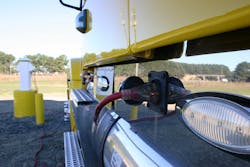Maybe you think this truck stop electrification (TSE) effort is a waste or time and money; then again, maybe you don’t.
Maybe you think connecting trucks parked overnight to electricity in order to operate heating, venting, and air conditioning (HVAC) systems along with TVs, laptops, and other devices without burning a drop of diesel is smart strategy – one that not only saves truckers money but reduces exhaust pollution and demand for imported oil as well.
If you’re in the latter category, here’s a heads up: you can obtain rebates through by Cascade Sierra Solutions to help you buy and install the necessary equipment on your trucks in order for them to “hook up” and operate off electrical power at 16 truck stops across the U.S.; a number that’s pegged to grow to 50 by the project’s end.
Thing is, though, you’d better hurry, for these rebates are going away very soon.
[Here’s a quick look at how truck stop electrification is supposed to work, courtesy of Shorepower Technologies.]
And we’re not talking about a few measly dollars here, either. Take James Thiele, for example: a 20-year veteran owner-operator who operates under the name JRT Logistics LLC. He purchased a $4,600 Hammond HVAC system capable of operating off pure electricity provided by either six deep-cycle batteries (costing $300 apiece) or plug-in power at a truck stop. He applied for a Cascade Sierra grant and got $1,100 to help cover his costs.
Another company, with the unlikely name of Smooth Operators, received rebates of $1,820 and $1,600, respectively, via Cascade Sierra to install an Idle Free HVAC system on a new truck and a Dynasys APU [auxiliary power unit] on a used model.
In fact, Cascade Sierra got about $10 million worth of rebate money as part of the $22 million package provided through the American Recovery and Reinvestment Act (ARRA) – more widely known as the “stimulus bill” – passed way back in 2009, courtesy of the U. S. Department of Energy.
That $10 million – of which only a rumored $3 million has been spent – is earmarked to provide idle reduction equipment rebates for devices on medium and heavy-duty diesel trucks that incorporate electric standby operation or run on battery power to eliminate engine idling during mandated off-duty time rest periods.
While battery-powered truck electrification systems aren’t cheap, the technology needed to equip a truck to run on “shore power” is relatively inexpensive. Indeed, I talked with Jeff Kim, president and CEO of Shorepower Technologies during the Technology & Maintenance Council’s annual meeting back in February and his firm is selling a simple truck cab power adapter kit that installs for just $100.In fact, the firm has been “seeding” the market by giving away 1,300 of these kits over the past few months to get truckers talking about the potential benefits such technology can provide in terms of reducing the need for truck engine idling.
“Everyone is looking for ways to leverage the power produced by the electrical grid in some fashion because it’s significantly cheaper than diesel,” Kim explained to me.
Look at it this way, he told me: a truck idling its engine consumes anywhere from a gallon to a gallon and a half of diesel per hour, which means a trucker is paying anywhere from $4 to $6 for the comfort and convenience the engine provides him during off-duty time.
By contrast, by using a cab-power kit and heavy-duty extension cord to connect trucks to Shorepower’s plug-in pedestals, truckers on pay $1 an hour for power – and in some locations, cable TV is rolled into the $1 price as well.
Shorepower expects to have its pedestals at more than 60 truck stops by the end of 2012, noted Alan Bates, the company’s vice president of marketing, with more on the way.
“Our 5-year goal is to have 500 to 1,000 truck stop locations offering our electrification service,” he said. “Electrification for trucking is rising to meet a growing demand. The high cost of fuel and anti-idling laws around the country make shore power a desired and affordable service for owner-operators, as well as fleets. We envision a national TSE network someday for long-haul trucking.”
Yet time will be the one to tell if that vision can indeed become reality.


